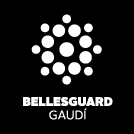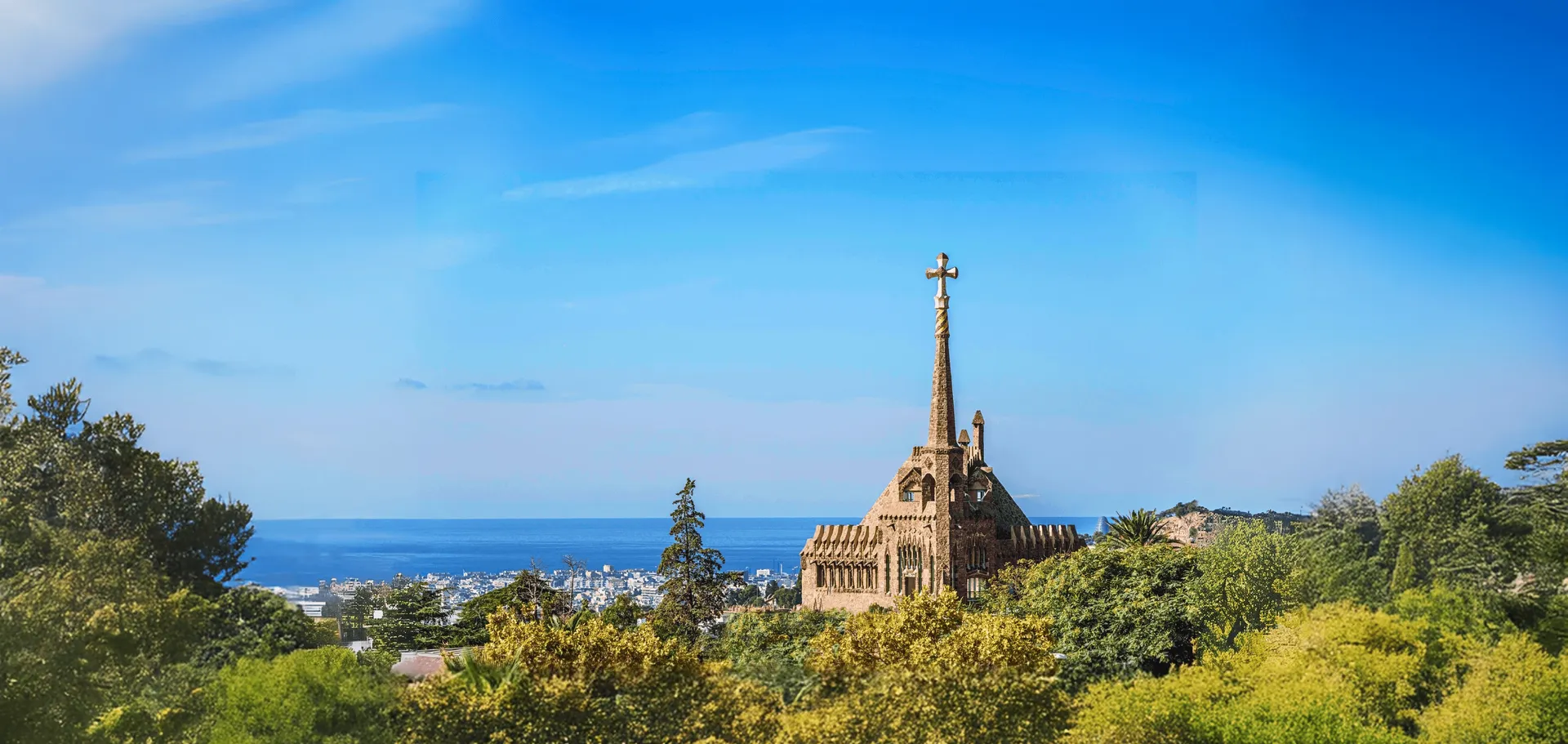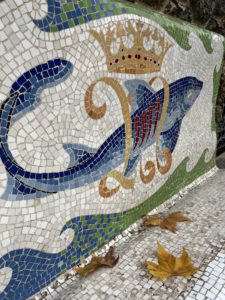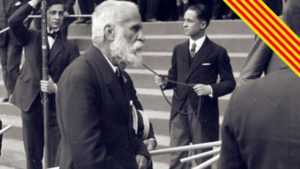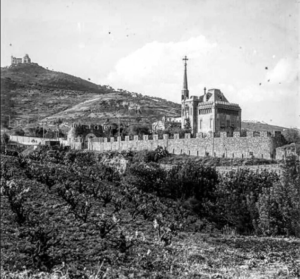October 3, 2025
By: Ferran Garcés
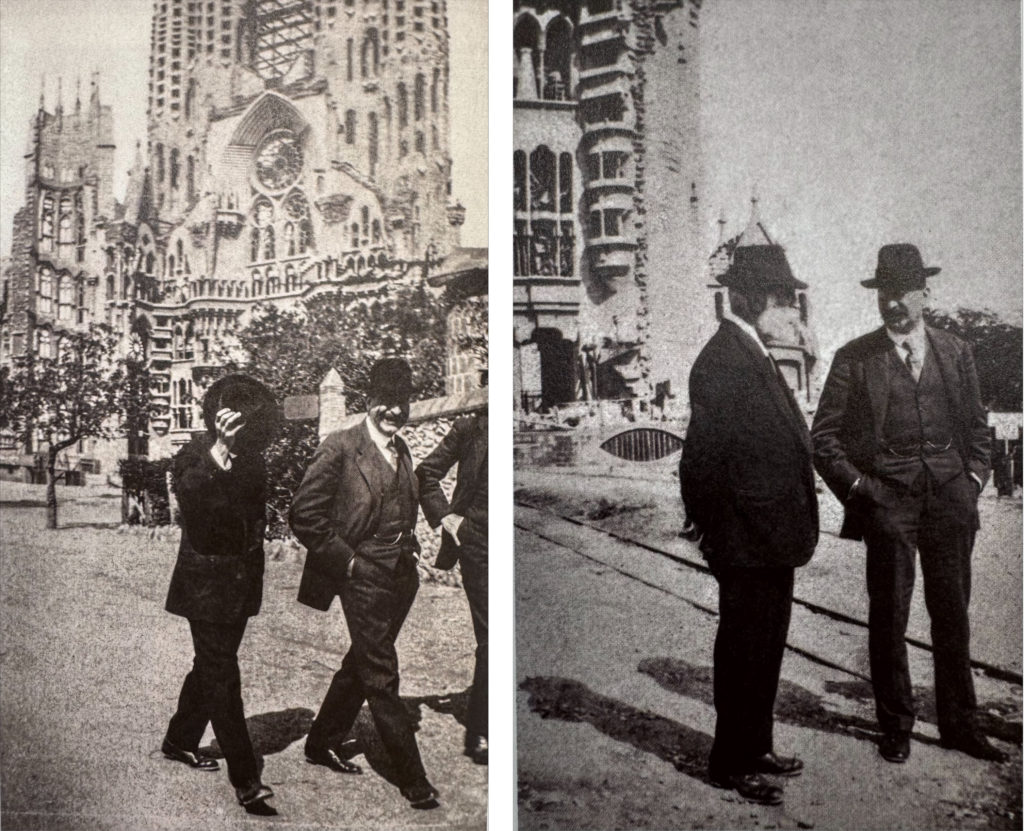
Gaudí strolling with Lluis Millet, 1920. Orfeó Documentation Center. Source: blog Museu Nacional d’Art de Catalunya.
In a 1920 photo, with the Sagrada Familia in the background, we see two friends walking. One of them is Lluís Milet, composer of music, and the other, next to him, Antoni Gaudí, hiding his face with his hat. Actually, that day two snapshots were taken. In the second, you can see the face of the architect, although only in profile and with the hat on (1)
In any case, both gestures say a lot about the personality of the architect, a reserved genius, no friend of portraits. For this reason so few images of him are known. However, few do not mean any. Today we have selected some to discover the genius under the hat, or profile…
1878: I am already an architect
On March 15, 1878, Gaudí finished his studies. He was twenty-six years old. He needed a photograph. It was the first one he had ever taken. The author, Pablo Audouard, was a prestigious portrait painter of the time. Upon obtaining the degree, Gaudí, with his usual sense of humor, commented to his friend the sculptor Llorenç Matamala: “Llorenç, they say I’m already an architect.” Forty-eight years later, the son of this same friend, also a sculptor, would be in charge of obtaining his mortuary mastegués, but for that, there was still a long way to go. A promising career opened up before that young graduate…
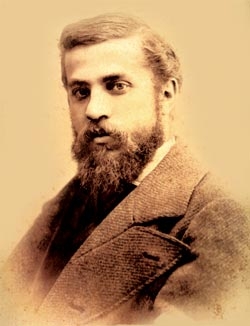
Portrait of Antoni Gaudí I Cornet. March 15, 1878. Author: Pablo Audouard,
Source: Wikipedia.
1883: Gaudí, on excursion
Two years before finishing his degree, that is, in 1876, Gaudí was already a member of the Catalan Association of Scientific Excursions, becoming one of the most puppy members of the institution. Another prominent partner, the poet Jacint Verdaguer, for example, was seven years older.
Of all the excursions in which they participated, one stands out that took place on June 17, 1883. That day, Gaudí and Verdaguer coincided in Banyuls and Elna, on an excursion that wanted to twin the literati of Catalonia with those of Roussillon. They were accompanied by great personalities of the time, such as the painter Alexandre de Riquer and the writers Víctor Balaguer, Angel Guimerà and Narcís Oller. The excursion was complemented by a spectacular reception, a sumptuous banquet and different literary sessions. In one of them, Verdaguer read a fragment of his poem Canigó, in the shelter of the inspiring atmosphere of the cloister of Elna. A graphic document has survived from that day. It is easy to discover Gaudí, he is the only one who does not look at the camera. Indeed, the promising architect appears in profile, looking at Verdaguer, in the center of the image (2) A few months after this photograph, in November 1883, Gaudí will join the project that will occupy him for the rest of his life: the Sagrada Familia.
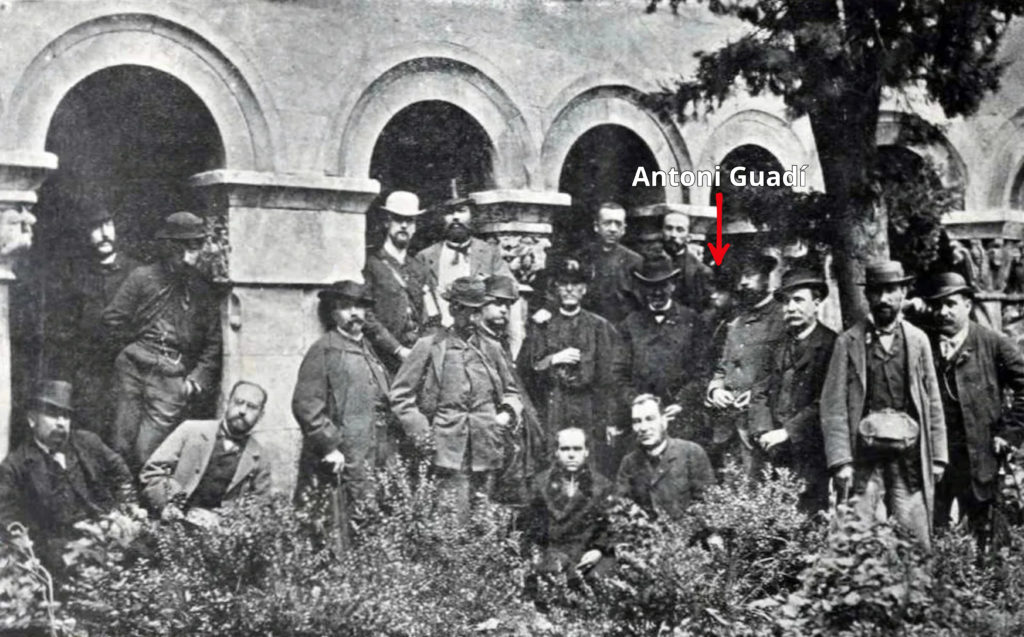
The group of intellectuals in Elna, June 1883. “La Ilustració Catalana”, no. 552, January 1914
1888: Gaudí bald…
When -and why- did Gaudí decide to cut his hair? We do not know, but we see it in the official photo of the card to access the universal exhibition of 1888. Once again, we have an image thanks to an official procedure, and not to the will of the person portrayed. At that time, Gaudí began to be a well-known architect, with important works in his portfolio. Among others, the Mataró Cooperative, Casa Vicens, El Capricho, Palau Güell, the Episcopal Palace of Astorga, and, of course, the Sagrada Familia, a project that, as we have already said, had assumed in 1883.
In Astorga, Gaudí will have long conversations with Bishop Joan Grau, also born in Reus and friend of his before. In 1888, the year of the photo of Gaudí bald, Joan Grau bought the land of Bellesguard, which at that time only occupied the ruins of the old palace of King Martin. Unfortunately, shortly after, the bishop died suddenly and the construction of Torre Bellesguard will still have to wait more than a decade.
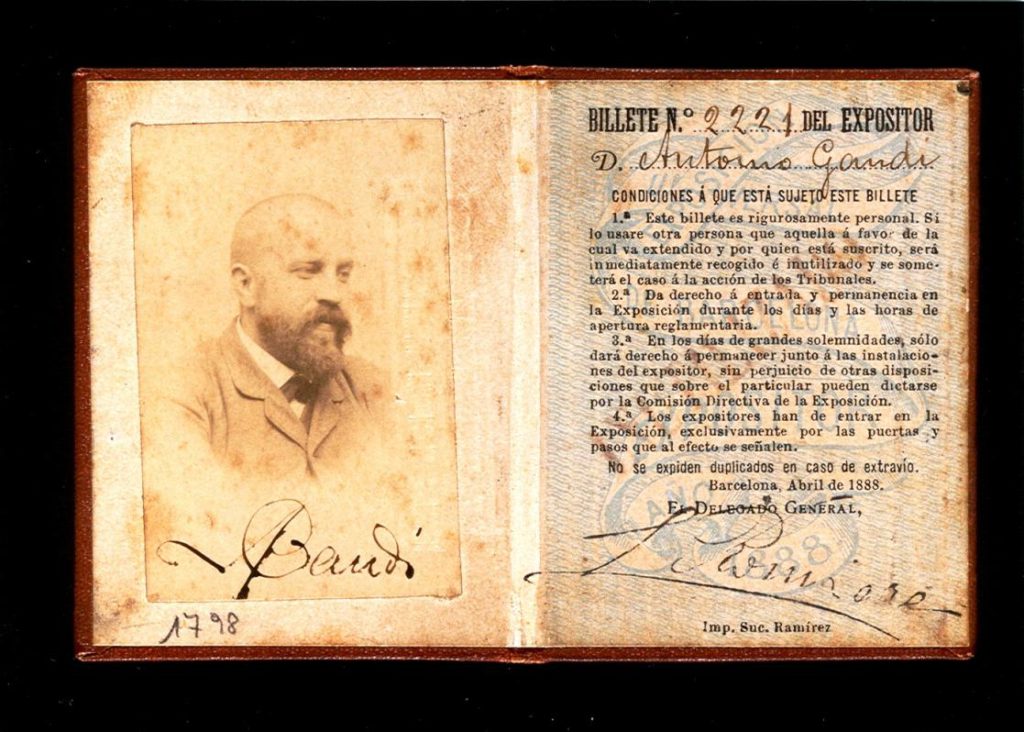
Pase de Antoni Gaudí para la Exposición Universal de 1888. Font: Reus Digital.
1892/93: A “pallasso” portraitist enters the scene…
In 1892, a young man born in Tarragona, like many of Gaudí’s collaborators, entered the Sagrada Família as an apprentice. As little discipline demonstrated in the studies, his father, to correct it, approached the teacher to make his son a person with trade.
For a time, he became a good delineator, but, rebellious in nature, he soon flew from the nest and became a very popular illustrator and caricaturist. That apprentice was called Ricard Opisso, and, despite frequenting the bohemian and libertine environments of the city, which Gaudí disliked so much, both professed great affection (3). The best proof of this curious relationship is the set of snapshots of Gaudí’s personal life made by Opisso (4) For example, this one where we see Gaudí’s father and niece in the company of Dr. Torras i Bages, bishop of enormous social influence, great friend of Gaudí, and the person who introduced him to the Catholic circles of the modernist period.
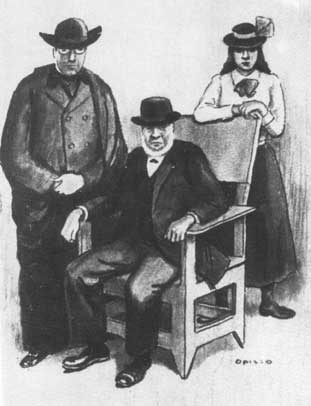
Rosa Egea with Francisco Gaudí -father of the architect, seated- and Dr. Torras i Bages. Drawing by Ricard Opisso, 1893. Source: Gaudi club.
1894: Gaudí about to die…
As a young man, Gaudí was an elegant young man and, according to some authors, even a little anticlerical. For reasons that are still subject to debate, all this will change with age, adopting ideas and increasingly spiritual habits.
During Easter, at 1894, this conversion led him to fast so extreme that he was about to die of starvation. Torras i Bages himself exhorted him to leave his rigorous attitude so that God’s design for him was another: to dedicate himself body and soul to the Temple of the Sagrada Familia. Thanks to Opisso, the apprentice díscol, we have an image of this chapter so transcendental in the life of the architect, although, as was usual in the cartoonist, with a comic air.
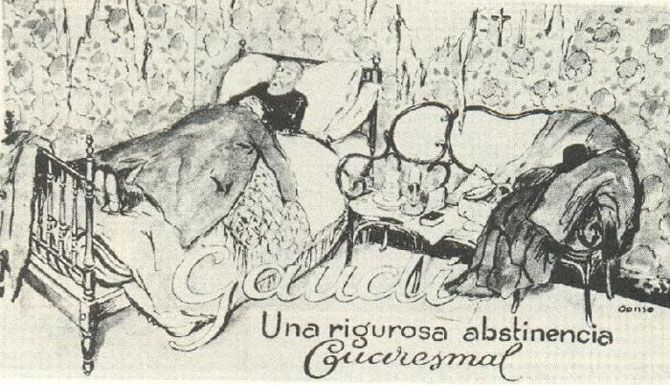
“Gaudi. A rigorous Easter Abstinence”, 1894. Drawing by Ricard Opisso, Source: “Astorga Redacción”.
1900: Trapped in fragantium…
As we see, where the cameras of the photographers did not arrive, the pencil of Opisso did. In 1900, the year Gaudí was hired to build Torre Bellesguard, the future caricaturist, surprised his mentor, and made him a quick portrait, which he entitled “Gaudí working in the Sagrada Familia workshop”. An image that no one else got. He will repeat the snapshot twice more, and, in one of them, Opisso himself will be portrayed next to Gaudí in the form of a buffoon (4).
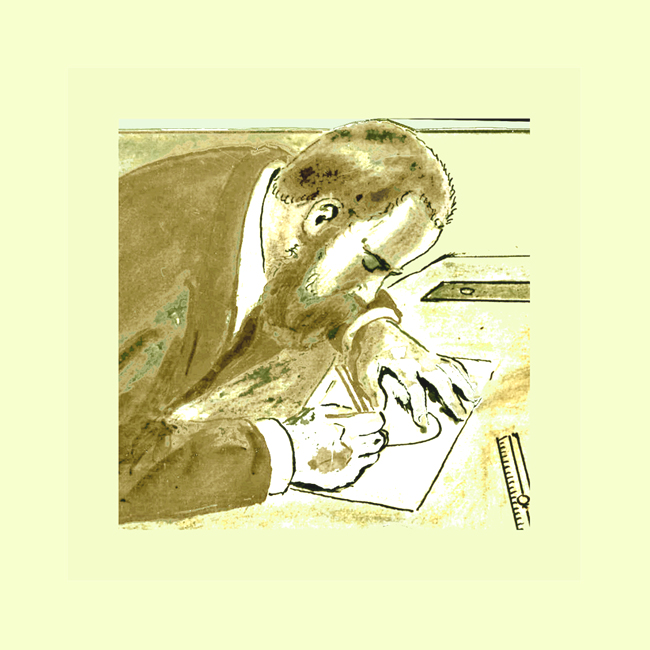
“Gaudí working in the workshop of the Sagrada Familia”, 1900. Drawing Ricard Opisso. Source: Antoni Gaudí Foundation
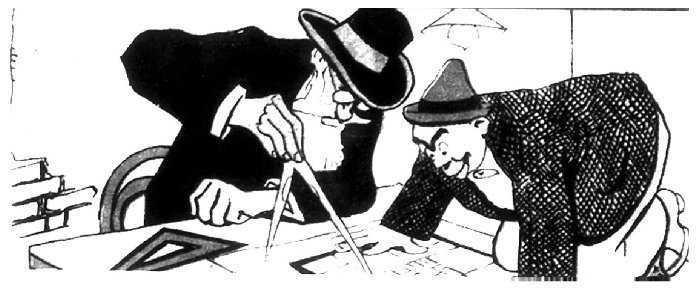
1902: The miracle of two painted portraits
At the beginning of the works of Torre Bellesguard, another friend of Gaudí worked a greater miracle, although that of Opisso. And the miracle are the only pictorial portraits of the architect in life.
The author was Joan Llimona, brother of the sculptor Josep Llimona, one of the main collaborators of Gaudí in the Sagrada Familia. Like the architect, the work of this painter was influenced by a strong religiousness. Both were members of the Cercle de Sant Lluc, an association supervised by Bishop Torras i Bagués and of which the Figueras were part, the family that had hired Gaudí to build Torre Bellesguard. In these paintings, Joan Llimona shows Sant Felip Neri with the face of Gaudí (see: “Gaudí already “appeared as a saint living”)
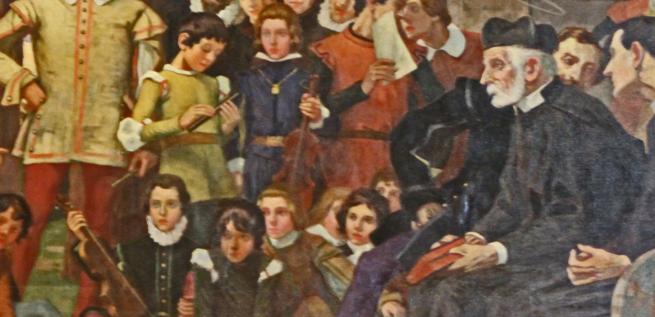
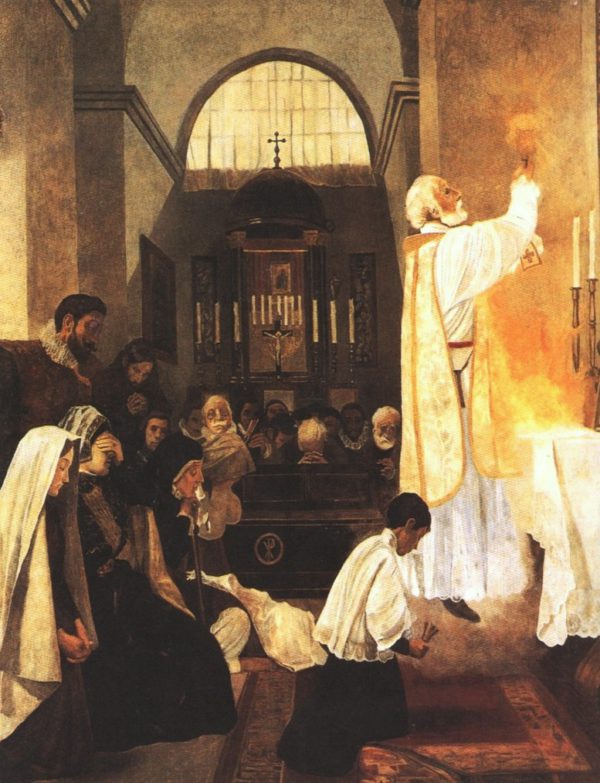
1904: Gaudí, smoking a pure.
Every summer, the Gaudí went up to the monastery of Montserrat to visit a common friend, Doctor Santaló. The architect felt a deep veneration for the Moreneta, a virgin very present in Bellesguard (see: devotion and history) The photo we show now, one of the best known of Gaudí, was obtained during one of these summer excursions. In the image we see Gaudí (in the background, smoking a puro and with a hat), his father (center), his niece Rosa, and Doctor Santaló, another great friend of the architect.
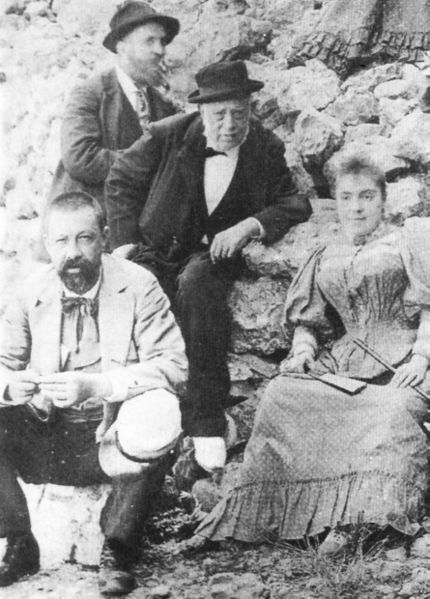
Antoni Gaudí (with puro and hat), with his father (in the centre), his niece Rosa, and Doctor Santaló, during a visit to Montserrat, 1904. Source: Wikipedia.
In short, the few images of Gaudí that they conserve are the result of his condition as an architect, such as the youth card, the result of a legal procedure. Among the exceptions, it is worth highlighting this image of the excursion to Montserrat, which show the teacher in a “leisure” situation, and the snapshots stolen by two of his friends, Opisso and Llimona, the only ones where he appears in “unofficial” situations. There are some more. We will discover them next Friday, when we will continue our route through the portraits of the genius under the hat…
Notes
(1) It is the image chosen by the cover of one of the last books about the architect: Lahuerta, Juan José (2021), Gaudí, National Art Museum of Catalonia, Barcelona, p. 290
(2) Valls, Esteve (19/09/2025), “1883: the brilliant Gaudí in Elna”, website La Semanine du roussillon
(3) Fondevila, M. (31/12/2021), “Ricard Opisso: memories and bittersweet anecdotes of Gaudí”, Museu Nacional de Catalunya.
(4) Anonymous author: “Salt in the light an unpublished portrait of Gaudí”, Antoni Gaudí Foundation.
